文章目录
- 1. Task Overview
- 2. Overall Workflow
- 3. Dataset 介绍
- 4. 代码介绍
- 4.1 环境介绍
- 4.2 下载 dataset
- 4.3 下载并加载模型
- 4.2 Notebook 代码
- 1)import 部分
- 2)固定 seed
- 3)加载 LLM
- 4)加载 tokenizer
- 5)设置解码参数
- 6)⭐ LLM 和 tokenizer 使用示例
- 7)generate_training_data 和 evaluate 函数
- 8)demo examples
- 9)Hyper Parameters
- 10)model 的量化和 LoRA
- 11)加载 dataset
- 12)Trainer
- 13)模型训练
- 14)运行 test
- 5. 总结
这个实验主要是 fine-tune 一个 LLM,让一个 LLM 能够写唐诗。
相关链接:
- Slides:Slides | Google Drive
- Code: colab
- Dataset: GitHub
- Video: Bilibili
1. Task Overview
给 AI 一首唐诗的前两个 sentences,我们希望它能够完成剩下的部分:
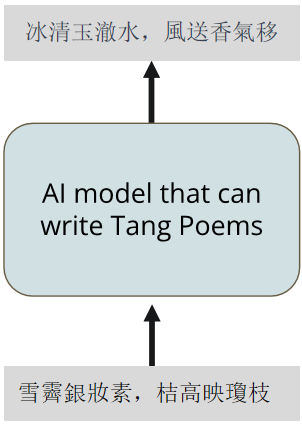
但是,原来的 LLM 可能并不具备这样的能力,我们希望经过 fine tune 之后,它能够最起码接一句像样的诗词:
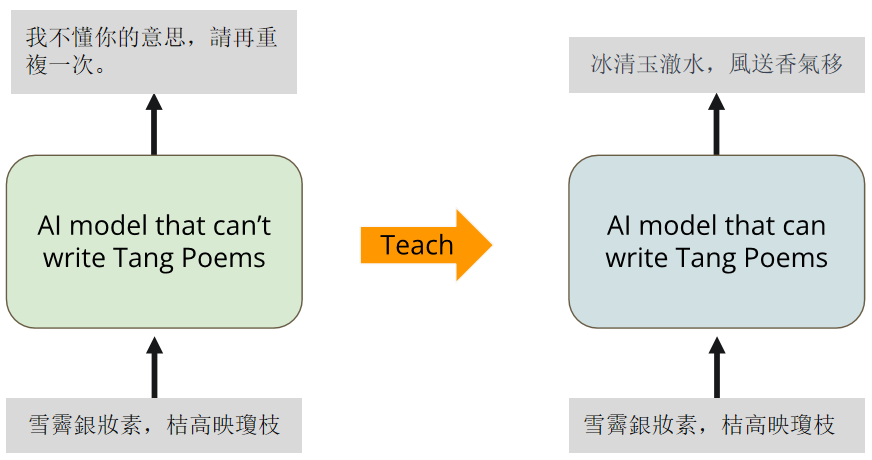
2. Overall Workflow
LLM 使用 MediaTek-Research/Breeze-7B-Instruct-v0_1:
MediaTek Research Breeze-7B (hereinafter referred to as Breeze-7B) is a language model family that builds on top of Mistral-7B, specifically intended for Traditional Chinese use.
数据集是一堆唐诗,一个 data point 的 example 如下:

总共有 5000 条数据。
微调的思路是:将一个 data point 的 instruction、input 和 output 填入 prompt template 中,形成一个 text,用来训练 LLM。
微调完成后,将 instruction、input 形成一个 prompt 输入给 LLM,让其完成剩下部分的唐诗。
3. Dataset 介绍
dataset 主要包含两个 JSON 文件:
Tang_testing_data.json:测试集,包含 15 条数据Tang_training_data.json:训练集,包含 5001 条数据
其中训练集每一条数据的格式都是前面 example 展示的,而测试集只包含 instruction 和 input 字段,答案在 Tang_testing_gt.txt 文件中:

4. 代码介绍
4.1 环境介绍
Python 3.10,torch 2.3.1
其他依赖如下:
!pip install bitsandbytes==0.43.0
!pip install datasets==2.10.1
!pip install transformers==4.38.2
!pip install peft==0.9.0
!pip install sentencepiece==0.1.99
!pip install -U accelerate==0.28.0
!pip install colorama==0.4.6
具体的代码可以下载课程给的 notebook,并查看其中的代码。
4.2 下载 dataset
git clone https://github.com/CheeEn-Yu/GenAI-Hw5.git
4.3 下载并加载模型
由于从 HuggingFace 下载模型可能会失败,所以可以从镜像站先下载模型:
HuggingFace 镜像站:https://hf-mirror.com/
这里介绍如何使用 huggingface-cli 下载模型。
- 安装依赖:
pip install -U huggingface_hub - 设置 mirror 环境变量:
export HF_ENDPOINT=https://hf-mirror.com - 设置 huggingface 的缓存目录:
export HF_HOME=/root/autodl-tmp/cache/ - 下载模型:
huggingface-cli download --resume-download MediaTek-Research/Breeze-7B-Instruct-v0_1
下载完成后,可以在目录中看到下载的预训练模型:

所在的目录就是 ${HF_HOME}/hub/ 中,之后代码需要从这个目录中加载模型。
4.2 Notebook 代码
1)import 部分
import os
import sys
import argparse
import json
import warnings
import logging
warnings.filterwarnings("ignore")import torch
import torch.nn as nn
import bitsandbytes as bnb
from datasets import load_dataset, load_from_disk
import transformers, datasets
from peft import PeftModel
from colorama import *from tqdm import tqdm
from transformers import AutoTokenizer, AutoConfig, AutoModelForCausalLM, BitsAndBytesConfig
from transformers import GenerationConfig
from peft import (prepare_model_for_int8_training,LoraConfig,get_peft_model,get_peft_model_state_dict,prepare_model_for_kbit_training
)
2)固定 seed
固定住 seed 从而防止训练的不确定性:
seed = 42
torch.backends.cudnn.deterministic = True
torch.backends.cudnn.benchmark = False
torch.manual_seed(seed)
if torch.cuda.is_available():torch.cuda.manual_seed_all(seed)
3)加载 LLM
这里使用 transformers 库的 AutoModelForCausalLM 来加载模型,并需要将 cache_dir 设置为下载的模型的目录。
cache_dir = "/root/autodl-tmp/cache/hub"nf4_config = BitsAndBytesConfig(load_in_4bit=True,bnb_4bit_quant_type="nf4",bnb_4bit_use_double_quant=True,bnb_4bit_compute_dtype=torch.bfloat16
)# 從指定的模型名稱或路徑載入預訓練的語言模型
model = AutoModelForCausalLM.from_pretrained(model_name,cache_dir=cache_dir,quantization_config=nf4_config,low_cpu_mem_usage = True
)
4)加载 tokenizer
加载 LLM 对应的 tokenizer:
# 創建 tokenizer 並設定結束符號 (eos_token)
logging.getLogger('transformers').setLevel(logging.ERROR)
tokenizer = AutoTokenizer.from_pretrained(model_name,add_eos_token=True,cache_dir=cache_dir,quantization_config=nf4_config
)
tokenizer.pad_token = tokenizer.eos_token
将 tokenizer 的 padding token 设定为 0:
tokenizer.pad_token_id = 0
5)设置解码参数
设置模型做 inference 时的 decoding 参数:
# 設定模型推理時需要用到的decoding parameters
max_len = 128
generation_config = GenerationConfig(do_sample=True,temperature=0.1,num_beams=1,top_p=0.3,no_repeat_ngram_size=3,pad_token_id=2,
)
6)⭐ LLM 和 tokenizer 使用示例
这里使用一个 data point example 来展示一下 LLM 和 tokenizer 的使用示例。
下面的代码使用 instruction 和 poem 组成一个 prompt:
instruction = '以下是一首唐詩的第一句話,請用你的知識判斷並完成整首詩。'
poem = '相見時難別亦難,東風無力百花殘。'prompt = f"""\
[INST] <<SYS>>
You are a helpful assistant and good at writing Tang poem. 你是一個樂於助人的助手且擅長寫唐詩。
<</SYS>>{instruction}
{poem}
[/INST]"""
组成的 prompt 如下:

然后使用 tokenizer 对 prompt 做分词,得到分词后的各个 token 的 token_id:
inputs = tokenizer(prompt, return_tensors="pt")

tokenizer 分词的结果 inputs 包含两个字段:
input_ids:size 为 [batch,分词后 tokens 的个数],其中的每个元素是分词后的 token 在词表中的 token idattention_mask:size 与 input_ids 一样,元素值为 0/1,1 代表这个 token 有用,0 代表无用
为了验证一下,我们将 tokenizer 分词的结果中前面几个 token id 交给 tokenizer.convert_ids_to_token() 方法来将 token ids 转为字符串,可以看到这就是 prompt 的前几个字符。
attention_mask 的用处是:当 batch 大于 1 时,每一行元素的长度值是分词后字符数量最大的,比如两行 text 做分词,一行被分为 10 个 token,一行被分为 20 个 token,那么分词后的 input_ids 和 attention_mask 的 size 为 [2, 20],attention_mask[0] 就是前 10 个元素为 1,后 10 个为 0,attention_mask[1] 就是全部为 1。
现在我们可以把 input_ids 交给 LLM 做文本生成:
model_output = model.generate(input_ids=input_ids,generation_config=generation_config,return_dict_in_generate=True,output_scores=True,max_new_tokens=max_len,
)
输出的结果也是一堆 token ids:
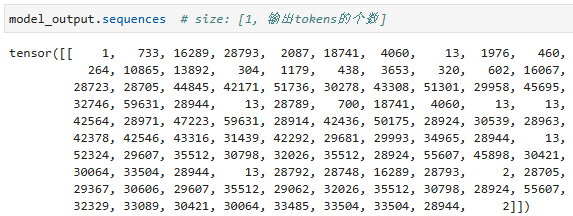
我们把这个 output 交给 tokenizer 做 decode 看一下结果:

7)generate_training_data 和 evaluate 函数
这里实现了两个重要的函数:
generate_training_data():输入一个包含 instruction、input 和 output 三个字段的 data point,将他们组成 prompt 并使用 tokenizer 分词,输出包含 input_ids 和 attention_mask 字段的 dict,这样的 dict 可以作为 transformers 库的 Trainer 用来训练 CasualLM 的样本。evalute():输入 instruction、input、decoding params,输出 LLM 的响应
具体的代码实现上,就是使用上面示例的思路。代码的实现如下:
# 生成訓練資料
def generate_training_data(data_point):"""(1) Goal:- This function is used to transform a data point (input and output texts) to tokens that our model can read(2) Arguments:- data_point: dict, with field "instruction", "input", and "output" which are all str(3) Returns:- a dict with model's input tokens, attention mask that make our model causal, and corresponding output targets(3) Example:- If you construct a dict, data_point_1, with field "instruction", "input", and "output" which are all str, you can use the function like this:formulate_article(data_point_1)"""# construct full input promptprompt = f"""\
[INST] <<SYS>>
You are a helpful assistant and good at writing Tang poem. 你是一個樂於助人的助手且擅長寫唐詩。
<</SYS>>{data_point["instruction"]}
{data_point["input"]}
[/INST]"""# count the number of input tokenslen_user_prompt_tokens = (len(tokenizer(prompt,truncation=True,max_length=CUTOFF_LEN + 1,padding="max_length",)["input_ids"]) - 1)# transform input prompt into tokensfull_tokens = tokenizer(prompt + " " + data_point["output"] + "</s>",truncation=True,max_length=CUTOFF_LEN + 1,padding="max_length",)["input_ids"][:-1]return {"input_ids": full_tokens,"labels": [-100] * len_user_prompt_tokens+ full_tokens[len_user_prompt_tokens:],"attention_mask": [1] * (len(full_tokens)),}# 進行生成回覆的評估
def evaluate(instruction, generation_config, max_len, input="", verbose=True):"""(1) Goal:- This function is used to get the model's output given input strings(2) Arguments:- instruction: str, description of what you want model to do- generation_config: transformers.GenerationConfig object, to specify decoding parameters relating to model inference- max_len: int, max length of model's output- input: str, input string the model needs to solve the instruction, default is "" (no input)- verbose: bool, whether to print the mode's output, default is True(3) Returns:- output: str, the mode's response according to the instruction and the input(3) Example:- If you the instruction is "ABC" and the input is "DEF" and you want model to give an answer under 128 tokens, you can use the function like this:evaluate(instruction="ABC", generation_config=generation_config, max_len=128, input="DEF")"""# construct full input promptprompt = f"""\
[INST] <<SYS>>
You are a helpful assistant and good at writing Tang poem. 你是一個樂於助人的助手且擅長寫唐詩。
<</SYS>>{instruction}
{input}
[/INST]"""# 將提示文本轉換為模型所需的數字表示形式inputs = tokenizer(prompt, return_tensors="pt")input_ids = inputs["input_ids"].cuda() # 分词后的所有 tokens 的 ids,size:[1, tokens长度]# 使用模型進行生成回覆generation_output = model.generate(input_ids=input_ids,generation_config=generation_config,return_dict_in_generate=True,output_scores=True,max_new_tokens=max_len,)# 將生成的回覆解碼並印出for s in generation_output.sequences:output = tokenizer.decode(s)output = output.split("[/INST]")[1].replace("</s>", "").replace("<s>", "").replace("Assistant:", "").replace("Assistant", "").strip()if (verbose):print(output)return output
8)demo examples
这里使用一些 demo examples 查看一下预训练的 LLM 在看到唐诗前两句后的输出结果:
""" It is recommmended NOT to change codes in this cell """# demo examples
test_tang_list = ['相見時難別亦難,東風無力百花殘。', '重帷深下莫愁堂,臥後清宵細細長。', '芳辰追逸趣,禁苑信多奇。']# get the model output for each examples
demo_before_finetune = []
for tang in test_tang_list:demo_before_finetune.append(f'模型輸入:\n以下是一首唐詩的第一句話,請用你的知識判斷並完成整首詩。{tang}\n\n模型輸出:\n'+evaluate('以下是一首唐詩的第一句話,請用你的知識判斷並完成整首詩。', generation_config, max_len, tang, verbose = False))# print and store the output to text file
for idx in range(len(demo_before_finetune)):print(f"Example {idx + 1}:")print(demo_before_finetune[idx])print("-" * 80)
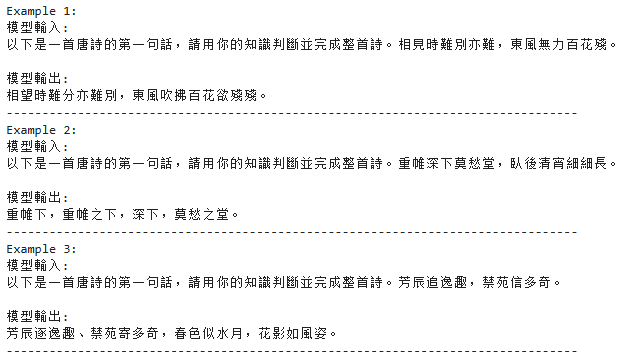
9)Hyper Parameters
这里设置一些超参数。
Lab 建议修改的参数有:
num_train_data = 1040 # 設定用來訓練的資料數量,可設置的最大值為5000。在大部分情況下會希望訓練資料盡量越多越好,這會讓模型看過更多樣化的詩句,進而提升生成品質,但是也會增加訓練的時間# 使用預設參數(1040): fine-tuning大約需要25分鐘,完整跑完所有cell大約需要50分鐘# 使用最大值(5000): fine-tuning大約需要100分鐘,完整跑完所有cell大約需要120分鐘ckpt_dir = "./exp1" # 設定model checkpoint儲存目錄 (如果想要將model checkpoints存在其他目錄下可以修改這裡)
num_epoch = 1 # 設定訓練的總Epoch數 (數字越高,訓練越久,若使用免費版的colab需要注意訓練太久可能會斷線)
LEARNING_RATE = 3e-4 # 設定學習率
不建议修改的参数有(可以先不用细看):
cache_dir = "./cache" # 設定快取目錄路徑
from_ckpt = False # 是否從checkpoint載入模型的權重,預設為否
ckpt_name = None # 從特定checkpoint載入權重時使用的檔案名稱,預設為無
dataset_dir = "./GenAI-Hw5/Tang_training_data.json" # 設定資料集的目錄或檔案路徑
logging_steps = 20 # 定義訓練過程中每隔多少步驟輸出一次訓練誌
save_steps = 65 # 定義訓練過程中每隔多少步驟保存一次模型
save_total_limit = 3 # 控制最多保留幾個模型checkpoint
report_to = None # 設定上報實驗指標的目標,預設為無
MICRO_BATCH_SIZE = 4 # 定義微批次的大小
BATCH_SIZE = 16 # 定義一個批次的大小
GRADIENT_ACCUMULATION_STEPS = BATCH_SIZE // MICRO_BATCH_SIZE # 計算每個微批次累積的梯度步數
CUTOFF_LEN = 256 # 設定文本截斷的最大長度
LORA_R = 8 # 設定LORA(Layer-wise Random Attention)的R值
LORA_ALPHA = 16 # 設定LORA的Alpha值
LORA_DROPOUT = 0.05 # 設定LORA的Dropout率
VAL_SET_SIZE = 0 # 設定驗證集的大小,預設為無
TARGET_MODULES = ["q_proj", "up_proj", "o_proj", "k_proj", "down_proj", "gate_proj", "v_proj"] # 設定目標模組,這些模組的權重將被保存為checkpoint
device_map = "auto" # 設定設備映射,預設為"auto"
world_size = int(os.environ.get("WORLD_SIZE", 1)) # 獲取環境變數"WORLD_SIZE"的值,若未設定則預設為1
ddp = world_size != 1 # 根據world_size判斷是否使用分散式數據處理(DDP),若world_size為1則不使用DDP
if ddp:device_map = {"": int(os.environ.get("LOCAL_RANK") or 0)}GRADIENT_ACCUMULATION_STEPS = GRADIENT_ACCUMULATION_STEPS // world_size
10)model 的量化和 LoRA
将模型准备好,并使用 INT 8 来训练:
model = prepare_model_for_int8_training(model)
使用 LoraConfig 配置 LoRA 模型:
config = LoraConfig(r=LORA_R,lora_alpha=LORA_ALPHA,target_modules=TARGET_MODULES,lora_dropout=LORA_DROPOUT,bias="none",task_type="CAUSAL_LM",
)
model = get_peft_model(model, config)
11)加载 dataset
读取原数据集,并将所需要用到的数据写入到一个 tmp_dataset.json 文件中:
with open(dataset_dir, "r", encoding = "utf-8") as f:data_json = json.load(f)
with open("tmp_dataset.json", "w", encoding = "utf-8") as f:json.dump(data_json[:num_train_data], f, indent = 2, ensure_ascii = False)
加载为 huggingface 的 Dataset 类型:
data = load_dataset('json', data_files="tmp_dataset.json", download_mode="force_redownload")
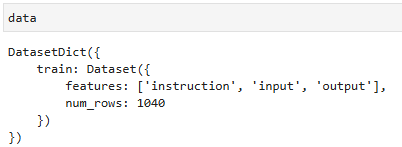
按照超参数的设置,将 dataset 分为 train-set 和 valid-set:
# 將訓練數據分為訓練集和驗證集(若 VAL_SET_SIZE 大於 0)
if VAL_SET_SIZE > 0:train_val = data["train"].train_test_split(test_size=VAL_SET_SIZE, shuffle=True, seed=42)train_data = train_val["train"].shuffle().map(generate_training_data)val_data = train_val["test"].shuffle().map(generate_training_data)
else:train_data = data['train'].shuffle().map(generate_training_data)val_data = None
12)Trainer
使用 transformers 库的 Trainer 进行模型训练:
model.config.use_cachee = False# 使用 Transformers Trainer 進行模型訓練
trainer = transformers.Trainer(model=model,train_dataset=train_data,eval_dataset=val_data,args=transformers.TrainingArguments(per_device_train_batch_size=MICRO_BATCH_SIZE,gradient_accumulation_steps=GRADIENT_ACCUMULATION_STEPS,warmup_steps=50,num_train_epochs=num_epoch,learning_rate=LEARNING_RATE,fp16=True, # 使用混合精度訓練logging_steps=logging_steps,save_strategy="steps",save_steps=save_steps,output_dir=ckpt_dir,save_total_limit=save_total_limit,ddp_find_unused_parameters=False if ddp else None, # 是否使用 DDP,控制梯度更新策略report_to=report_to,),data_collator=transformers.DataCollatorForLanguageModeling(tokenizer, mlm=False),
)
13)模型训练
使用 trainer 进行模型训练,并保存预训练结果:
trainer.train()
model.save_pretrained(ckpt_dir)
14)运行 test
前面的训练过程保存了一系列 checkpoints(ckpt),这里展示所有可用的 ckpt:
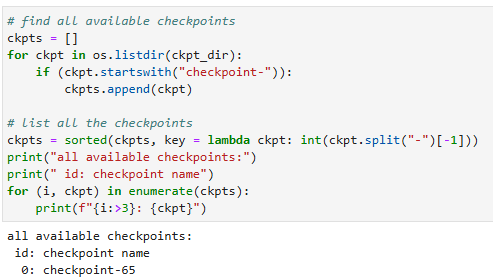
选择使用的 ckpt:
id_of_ckpt_to_use = -1 # 要用來進行推理的checkpoint的id(對應上一個cell的輸出結果)# 預設值-1指的是上列checkpoints中的"倒數"第一個,也就是最後一個checkpoint# 如果想要選擇其他checkpoint,可以把-1改成有列出的checkpoint id中的其中一個ckpt_name = os.path.join(ckpt_dir, ckpts[id_of_ckpt_to_use])
调整 decoding paramters:
# 你可以在這裡調整decoding parameter,decoding parameter的詳細解釋請見homework slides
max_len = 128 # 生成回復的最大長度
temperature = 0.1 # 設定生成回覆的隨機度,值越小生成的回覆越穩定
top_p = 0.3 # Top-p (nucleus) 抽樣的機率閾值,用於控制生成回覆的多樣性
# top_k = 5 # 調整Top-k值,以增加生成回覆的多樣性和避免生成重複的詞彙
从指定的 checkpoint 加载模型权重:
test_data_path = "GenAI-Hw5/Tang_testing_data.json"
output_dir = "./output" # 設定作業結果輸出目錄 (如果想要把作業結果存在其他目錄底下可以修改這裡,強烈建議存在預設值的子目錄下,也就是Google Drive裡)
output_path = os.path.join(output_dir, "results.txt")cache_dir = "/root/autodl-tmp/cache/hub" # 設定快取目錄路徑
seed = 42 # 設定隨機種子,用於重現結果
no_repeat_ngram_size = 3 # 設定禁止重複 Ngram 的大小,用於避免生成重複片段nf4_config = BitsAndBytesConfig(load_in_4bit=True,bnb_4bit_quant_type="nf4",bnb_4bit_use_double_quant=True,bnb_4bit_compute_dtype=torch.bfloat16
)# 使用 tokenizer 將模型名稱轉換成模型可讀的數字表示形式
tokenizer = AutoTokenizer.from_pretrained(model_name,cache_dir=cache_dir,quantization_config=nf4_config
)# 從預訓練模型載入模型並設定為 8 位整數 (INT8) 模型
model = AutoModelForCausalLM.from_pretrained(model_name,quantization_config=nf4_config,device_map={'': 0}, # 設定使用的設備,此處指定為 GPU 0cache_dir=cache_dir
)# 從指定的 checkpoint 載入模型權重
model = PeftModel.from_pretrained(model, ckpt_name, device_map={'': 0})
运行 test dataset:
results = []# 設定生成配置,包括隨機度、束搜索等相關參數
generation_config = GenerationConfig(do_sample=True,temperature=temperature,num_beams=1,top_p=top_p,# top_k=top_k,no_repeat_ngram_size=no_repeat_ngram_size,pad_token_id=2
)# 讀取測試資料
with open(test_data_path, "r", encoding = "utf-8") as f:test_datas = json.load(f)# 對於每個測試資料進行預測,並存下結果
with open(output_path, "w", encoding = "utf-8") as f:for (i, test_data) in enumerate(test_datas):predict = evaluate(test_data["instruction"], generation_config, max_len, test_data["input"], verbose = False)f.write(f"{i+1}. "+test_data["input"]+predict+"\n")print(f"{i+1}. "+test_data["input"]+predict)
打印出的测试结果:

(很多还是很搞笑的)
5. 总结
以上代码展示了如何加载一个 LLM 并对其针对 specific task 做 fine tune,通过修改相应的 dataset 可以复用相关代码实现其他的特定任务微调。整个代码值得学习。
,拥塞控制(拥塞窗口,网络出现拥塞时,滑动窗口的大小如何确定,慢启动,阈值))



:动态规划——爬楼梯)

)


)



)
【权值更新与加权表决、数学公式】)




